 indicates that the locomotive is equipped with a DCC sound decoder. indicates that the locomotive is equipped with a DCC sound decoder.
Tank Locomotives
Fleischmann 406101
DB BR64 Tank Steam Locomotive [outfitted for DCC with ESU LokPilot decoder]
The Class 64 was developed starting in 1926 and 520 were built between 1928 and 1940. The steam locomotives of DB Class 64 were used as passenger train locomotives and given the nickname "Bubikopf" ("bobhead") after a fashionable ladies' hairstyle of the time. They were taken out of service in 1975, though 6 remain operational as historical locomotives, 3 of which are in Germany. This model was reissued by Fleischmann in 2012 to celebrate its 125th anniversary.

Fleischmann 4065
DB BR65 Tank Steam Locomotive
Built between 1951 and 1956, the steam locomotives of DB Class 65 were newly-designed, German passenger train tank locomotives, built for the Deutsche Bundesbahn after the Second World War. They were intended for suburban and commuter trains serving German cities. Numbers 65 012 - 65 018 were equipped for push-pull service (this model's running number is 65 018). They were taken out of service in 1966.
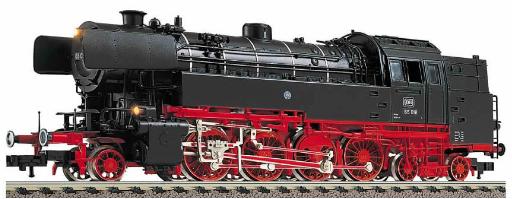
Fleischmann 481105
DB BR78 Tank Steam Locomotive [outfitted for DCC with ESU LokPilot decoder]
Originally the Prussian Class T 18, the class 78 was between 1951 and 1956. It could run equally fast forwards and backwards and could be operated on return journeys without having to be turned on a turntable. It was retired from service in 1975.

Roco 72271 
DB BR85 Tank Steam Locomotive [outfitted for DCC Sound and dynamic smoke with factory-installed Zimo decoder]
In 1931, the DR ordered ten heavy tank locomotives that went into service on the Höllentalbahn in order to replace the cogwheel locomotives operating there. The Höllentalbahn in the Black Forest has a steep incline of up to 5.5%, one of the steepest in Germany, thus requiring such a powerful locomotive to pull or push trains up the grade. The last Class 85 was taken out of service by the DB in 1961 as the lines were electrified and steam locomotives were replaced by electric. Though I model the period around 1970 on the Poggenbahn, I thought this long-awaited model (it took more than two years for Roco to deliver it after it was first announced) was so spectacular I couldn't resist—so I've made a exception in my historical accuracy to include it.

Fleischmann 4086
DB BR86 Tank Steam Locomotive [outfitted for DCC with ESU LokPilot decoder]
In the 1920s, there was a need for a tank loco designed for mixed traffic use on heavily used branch lines. Many German manufacturers were responsible for this steam locomotive, classified as Class 86, with up to 800 engines being delivered between 1928-1943. The last Class 86 was taken out of service by the DB in 1974.
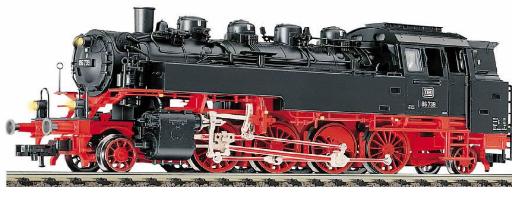
Fleischmann 4090
DB BR94 Tank Steam Locomotive [outfitted for DCC with ESU LokPilot decoder]
The Prussian T 16.1 locomotives were built for the Prussian state railways as goods train tank locomotives about the time of the First World War. A total of 1,242 examples were built between 1913 and 1924. In addition to heavy shunting and line duties the locomotives were also employed on steep lines, and the great success of this class on inclines made it possible to do away with fiddly and time-consuming rack railway operations on many ramps.In the Bundesbahn the last examples of this class were retired in 1974.
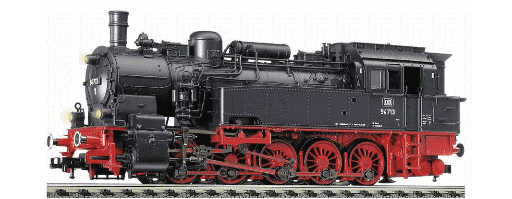
Lenz 30201 
DB BR66 Tank Steam Locomotive [factory outfitted for DCC Sound]
In 1955 the DB developed the Class 66 tank loco, intended for express train service on DB main- and branchlines. Although the 66 was a successful design, the advent of diesel locomotives meant that only two Class 66 locomotives were ever built. They were retired from service in 1968.
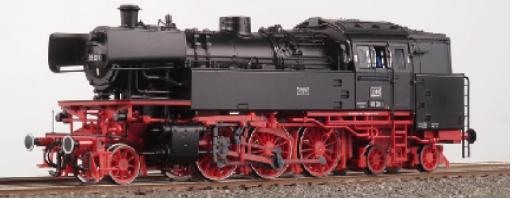
Tender Locomotives
Fleischmann 414001
DB BR24 Tender Steam Locomotive [outfitted for DCC with ESU LokPilot decoder]
The Class 24 tender steam locomotive, was manufactured from 1924 to 1940 as a passenger train locomotive and was also used in branch line service. It could achieve a top speed of 90 km/h and 95 models were built. The DB took possession of 47 locomotives which remained in service in the DB until 1966.

Fleischmann 4166
DB BR38 Tender Steam Locomotive [outfitted for DCC with ESU LokPilot decoder]
The Class 38 tender steam locomotive, originally the Prussian P8, was manufactured from 1908 to 1926. It could achieve a top speed of 100 km/h and 1,200 models were built. It remained in service in the DB until 1974. This version had a so-called "wannentender" or "bathtub tender" with curved sides.

Fleischmann 410303
DB BR03 Tender Steam Locomotive [outfitted for DCC with ESU LokPilot decoder]
The Class 03 tender steam locomotive were built between 1930 and 1938 as express train locomotives for routes that were only suitable for axle loads of up to 18 tons. Because they had a lighter frame, the locomotives used less steam and thus were more economical to operate. 298 examples of this engine, whose construction was based on the Class 01, were built by the firms of Borsig, Krupp, Henschel, and Schwartzkopff. The last ones were withdrawn from DB service in 1972.
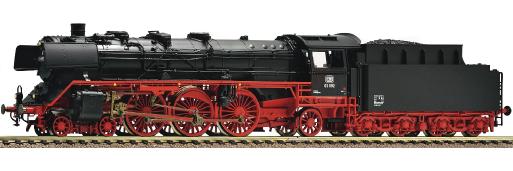
Roco 70250 with Digital Sound 
DB BR23 Tender Steam Locomotive [outfitted for DCC Sound with factory-installed Zimo decoder]
The Class 23 tender steam locomotive was the last steam engine to enter service in the Federal Republic of Germany. It was specifically designed primarily for mixed passenger service but ended up also being used for freight, replacing the once ubiquitous Prussian P 8 engines that had been built between 1908 and 1924 and, in their day, were the most numerous post-war replacement class. 105 examples of this newly designed class were manufactured starting in 1950. They had welded locomotive frames, boilers and tenders together with all the latest refinements of German practice. These included a superheated multiple-valve regulator and central lubrication of the least accessible parts of the running gear. BR23s could pull a 600 ton train on a flat route at 120 km/hour and on an incline of 10 per mille at 44 km/hour. The last few locomotives were retired to the Crailsheim locomotive depot (Bahnbetriebswerk Crailsheim) in 1976. 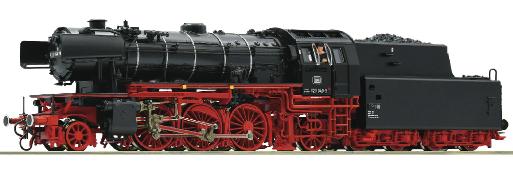
Fleischmann 4175
DB BR50 Tender Steam Locomotive with Cabin Tender [outfitted for DCC with ESU LokPilot decoder]
The Class 50 was built to haul freight trains and at the end of the steam locomotive era it became virtually a universal class of mixed-traffic steam engines that, thanks to its low axle load, could even be employed on branch lines with light track beds. The Deutsche Bundesbahn grouped the locomotives into Classes 050, 051, 052 and 053 from 1968 so that the numbers were computer-compatible. 3,164 of these locomotives were built between 1939 and 1959, and the last ones were retired from DB service in 1987. This beautiful Fleischmann model features the "Kabinentender", or cabin tender, which included a fairly cramped compartment that acted as a caboose from which the train could be seen.
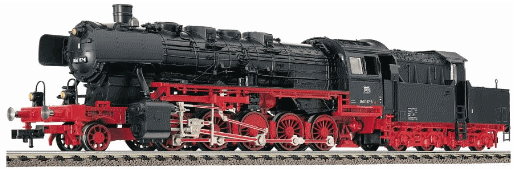
Fleischmann 415473 with Digital Sound 
DB BR55 Tender Steam Locomotive [outfitted for DCC Sound with factory-installed decoder]
The Class 55 tender steam locomotive (Prussian G 8.1) were built between 1913 and 1921 as freight and shunting locomotives. These locomotives had a larger boiler and therefore were heavier, giving it more traction. However, because of their significant weight of 69.9 tons they could only run on main lines. This was a very successful engine and a total of 5,155 engines were built, making it the most-built "Länderbahnlokomotive" and the overall second most-built locomotive after the BR 52. It was taken out of DB service in 1972, and museum locomotive 55 3345 is housed at the Eisenbahnmuseum Bochum Dahlhausen. This beautiful model is one of Fleischmann's last H0 scale steam locomotives and features digital couplers and an orange LED in the cab which glows like the firebox.
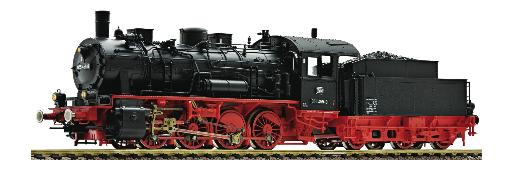
Fleischmann 74118 with Digital Sound 
DB BR18 Tender Steam Locomotive [2 models outfitted for DCC Sound with factory-installed ESU LokSound decoder]
At the beginning of the 1950's there was a shortage of powerful express locomotives on the DB. For this reason around thirty of the 18.5 locomotives were given new welded replacement boilers, new fireboxes, new Wagner smoke deflectors and new cabs. Adding these new features the DB changed the loco number from 18.5 to 18.6 The new 18.6 locomotives were considered one of the most economical steam locomotives in the DB fleet. Until they were taken out of service in the late 1960's the 18.6 locomotives travelled over 30 million kilometers.

Roco 62192 
DB BR10 Tender Steam Locomotive [outfitted for DCC Sound with Roco/Fleischmann decoder]
In 1957 the DB decided to build a new steam locomotive and built two specimens, numbered 10 001 and 10 002. They had originally been seen as a replacement for the class 01, 03, 18.5 and 39 locomotives. However, as a result of their late delivery, high axle load of over 22 tons (which restricted its use to only a few routes) and structural changes to rail operations, this plan did not come to fruition. Both engines were designed to greatly reduce maintenance and repair costs. These were elegant locomotives which had a conical smokebox door and partial streamlining which protected the cylinders from dirt and from cooling too rapidly and, at the same time, was supposed to reduce wind resistance. The fully welded boiler was the same as the newly designed one used to re-equip the DRG Class 01.10 from 1953.
Locomotive 10 002 was retired after a side rod broke in January 1967 and number 10 001 was retired in June 1968. My model has running number 10 002.

Fleischmann 1362
DB BR01 Pacific Class Tender Steam Locomotive
The BR 01 steam locomotives. nicknamed the "Schwarze Gigant" ("Black Giant") were the first standardized (Einheitsdampflokomotive) steam express passenger locomotives built by the unified German railway system from 1926 to 1938. They were of 4-6-2 "Pacific" class wheel arrangement. The idea of standardization was that it would reduce maintenance costs: if a BR 01 whose engine shop was in Berlin broke down in Dresden, instead of having to ship the necessary part from Berlin and take the locomotive out of service, a part from the Dresden shop could be used as all of the engines, parts, and workings were exactly the same and produced nationwide. Thus it was a "standard" product for engine shops. These powerful engines could originally achieve a top speed of 120 km/hr and were later modified to achieve 130 km/hr speeds. The BR 01s remained in operation until 1982. This model was a Christmas gift from my parents in 1970 and is still a good runner. The original locomotive with running number 01 220 is no longer in service and is now a monument locomotive at the DB Museum in Nürnberg in the DB configuration with Witte smoke deflectors and a new construction boiler. I'm very attached to this model because it was a Christmas present from my parents in 1972, a surprise which my mother's sister Berta bought in Landshut and sent to Rome for me to unexpectedly find under our Christmas tree.
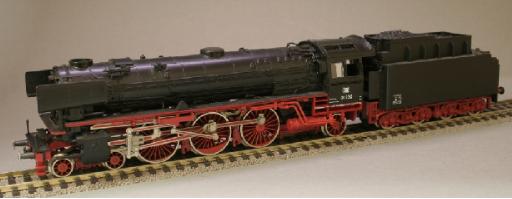
Precision Craft Models PCM -713 
DB BR01 Pacific Class Tender Steam Locomotive [Outfitted for DCC Sound with factory-installed ESU LokSound decoder]
In 2006/2007, Precision Craft Models (PCM) decided to manufacture a German Class 01 steam locomotive for the German market. PCM had traditionally focused on US models so this was a departure from their standard product. The locomotive was attractively priced and featured an ESU Loksound DCC decoder with sound. The original locomotive with running number 01 202 is still in service, operated by Verein Pacific 01 202 in Switzerland.

Source: Wikipedia.

|


















